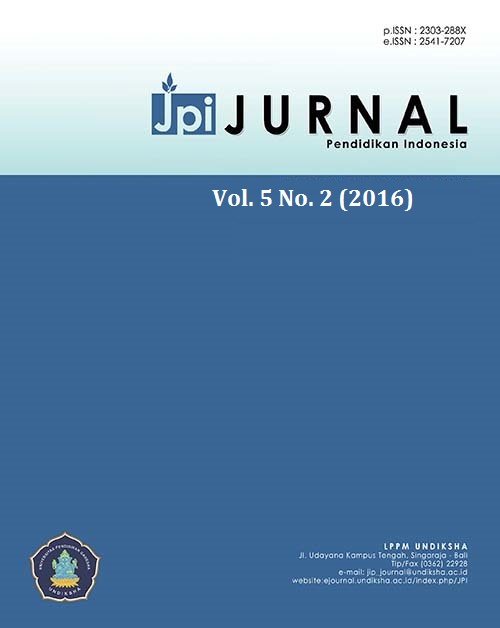PENGEMBANGAN MULTIMEDIA PEMBELAJARAN TEMATIK INTEGRATIF UNTUK SISWA KELAS IV SEKOLAH DASAR
DOI:
https://doi.org/10.23887/jpi-undiksha.v5i2.8475Keywords:
Kurikulum 2013, Multimedia, TematikAbstract
Penelitian ini adalah penelitian pengembangan yang bertujuan untuk mendeskripsikan hasil perancangan multimedia pembelajaran tematik Kurikulum 2013 untuk siswa Sekolah Dasar Kelas IV yang berkualitas dan siap untuk diimplementasikan dalam pembelajaran. Data dikumpulkan melalui instrumen penilaian pakar media pembelajaran, pakar desain multimedia, dan pakar pembelajaran tematik. Multimedia diujicobakan secara perorangan dan kelompok kecil untuk memperoleh respon user. Data dianalisis dengan analisis deskriptif kuantitatif. Hasil penilaian oleh pakar media pembelajaran, pakar desain multimedia, dan pakar pembelajaran tematik, menunjukkan bahwa multimedia yang dikembangkan sudah berkualifikasi baik. Hasil uji perorangan yang dilakukan oleh Guru Kelas IV SD Laboratorium Undiksha menunjukkan bahwa multimedia berkualifikasi sangat baik, dan hasil uji kelompok kecil diperoleh bahwa multimedia berkualifikasi baik. Hal itu berarti multimedia yang dikembangkan sudah siap untuk digunakan secara publik
References
Alfar, I. 2009. Preparation and Production of Interactive Multimedia Software, Second Edition. Delta Computer Technology: Egypt.
Agung, A. A. G. 2012. Metodelogi Penelitian Pendidikan. Singaraja: Undiksha.
Aloraini, S. I. 2005. Distance learning. Alretha Press: Kingdom of Saudi Arabia.
Andresen, B. B. & Brink, K. 2013. Multimedia in Education Curriculum. Moscow: UNESCO Institute for Information Technologies in Education.
Baharul Islam, M., Ahmed, A., Kabirul Islam, M. & Shamsuddin, A. K. 2014. Child Education Through Animation: An Experimental Study. International Journal of Computer Graphics & Animation (IJCGA),Vol.4, No.4.
Chaeruman, U. 2010. E-Learning dalam Pendidikan Jarak Jauh. Jakarta: Kemendiknas.
Gilakjani, A. P. 2012. The significant role of multimedia in motivating EFL learners’ interest in English language learning. I.J.Modern Education and Computer Science, Vol. 4, No .4, hlm. 57-66.
Shah, I. & Khan, M. 2015. Impact of Multimedia-aided Teaching on Students’ Academic Achievement and Attitude at Elementary Level. US-China Education Review A, Vol. 5, No. 5, hlm. 349-360
Lee, L. 2006. Information and Communication Technologies: Transforming Views of Literacies in Early Childhood Settings. ISSN, Vol. 26, No. 1, hlm. 46-62.
Lee, Y., & Keckley, K. 2006. Effects of a teacher-made multimedia program on teaching driver education: A case study. Teaching Exceptional Children Plus, Vol. 2, No. 5.
Nachimuthu, K. 2012. Pressures and Pressures of e-contents in Teaching. International Journal of New Innovations, Vol. 1, No. 2, hlm. 337-340.
Peraturan Menteri Pendidikan dan Kebudayaan Nomor 57 Tahun 2014. Jakarta: Kemendikbud.
Plomp, T. 1997. Educational and Training System Design. Enschede: University of Twente.
Shilpa, S. & Sunita, M. 2016. A study an interactive elementary education (3-6) with Multimedia. International Journal of Home Science, Vol. 2, No. 1, hlm. 214-215.
Soland, J., Hamilton, L. S. & Stecher, B. M. 2013. Measuring 21st Century Competencies: Guidance for Educators. Tersedia di http://asiasociety.org/ diakses tanggal 20 Oktober 2016
Suarsana, I M., & Mahayukti, G.A. 2013. Pengembangan E-Modul Berorientasi Pemecahan Masalah untuk Meningkatkan Keterampilan Berpikir Kritis Mahasiswa. Jurnal Pendidikan Indonesia. Vol. 2, No. 2, hlm. 264-275.
Suwindra, I. N. P. 2004. Penerapan Model Pembelajaran Fisika Interaktif Berbasis Web di Kelas I SMU Negeri 1 Singaraja. Jurnal Pendidikan dan Pengajaran. No 3, hlm. 85-95.
Suwindra, I N. P., Sujanem, R., & Suswandi, I. 2012. Pengembangan Modul Software Multimedia Interaktif dengan Strategi Pembelajaran Berbasis Masalah untuk Meningkatkan Pemahaman Konsep dan Hasil Belajar Fisika Siswa Kelas XII SMA. Jurnal Pendidikan Indonesia. Vol. 1, No.1, hlm. 13-27.
Vaughan, T. 2011. Multimedia: Making It Works, Eight Edition. New York: McGraw-Hill Companies
William, D.C., Pedersen, S., & Liu, M. 1998. An Evaluation of the Use of Problem-Based Learning Software By Middle School Students. Journal of Universal Komputer Science. Vol. 4, No. 4, hlm 466-483.
Downloads
Published
Issue
Section
License
Authors who publish with the Jurnal Pendidikan Indnesia agree to the following terms:
- Authors retain copyright and grant the journal the right of first publication with the work simultaneously licensed under a Creative Commons Attribution License (CC BY-SA 4.0) that allows others to share the work with an acknowledgment of the work's authorship and initial publication in this journal.
- Authors are able to enter into separate, additional contractual arrangements for the non-exclusive distribution of the journal's published version of the work (e.g., post it to an institutional repository or publish it in a book), with an acknowledgment of its initial publication in this journal.
- Authors are permitted and encouraged to post their work online (e.g., in institutional repositories or on their website) prior to and during the submission process, as it can lead to productive exchanges, as well as earlier and greater citation of published work. (See The Effect of Open Access)








